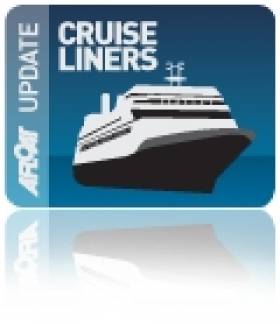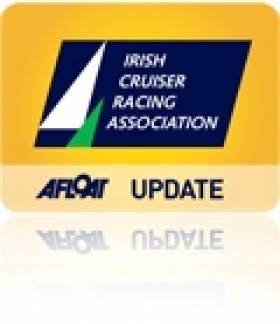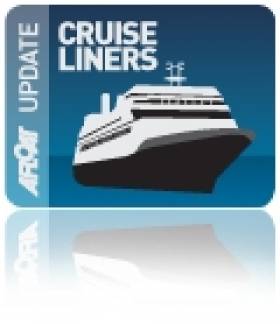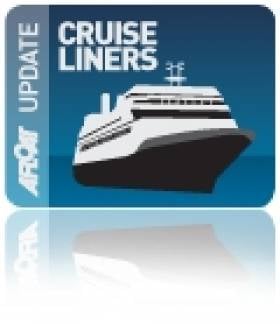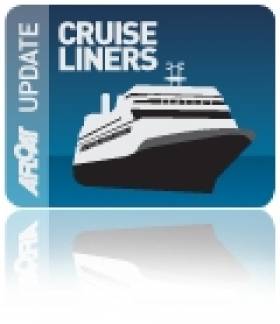Displaying items by tag: Cruise
#windsurf – The five-mast Wind Surf cruise yacht will dock at Dun Laoghaire Harbour at 7am on Saturday, 12th July. It will remain docked at the south Dubllin Bay port until 6.30pm when it will depart to the Isle of Man. It also visited Dublin Bay on Wednesday emerging from Dublin Port under sail.
The Wind Surf is the largest ship in the Windstar Cruises fleet and is known for its luxurious amenities carrying 312 guests and 191 international staff. The Wind Surf, one part sailing yacht and one part upscale cruise ship, has seven triangular, self-furling, computer operated sails.
'Wind Surf' arrives in DL pic.twitter.com/B4aa2rv0tv
— Gareth (@garethoconnor) July 12, 2014
Stars from across Ireland have signed up to take the trip of a lifetime, on board a special cruise celebrating the best in Irish music and comedy talent.
The eight-night Christmas Market Irish Show Cruise 2014 will depart from Dublin on 10 December visiting Hamburg and Bremen before cruising up the North Sea Canal into Amsterdam and on to Bruges before returning to Dublin.
Featuring huge Irish entertainment stars including compere Gene Fitzpatrick, Ireland's own 'Queen of Country Music' Philomena Begley, comedian Conal Gallen, singer/songwriter Johnny Brady, broadcaster Hugo Duncan and country music sensation Robert Mizzell, the cruise offers an unmissable line-up for Irish music and entertainment fans.
Guests will be able to enjoy the superb facilities of Fred Olsen's Boudicca, complete with six different dining options, pool deck and Atlantis Spa, while enjoying jam-packed shows every evening showcasing the best of Irish talent.
The full star studded line-up also includes Irish country star Barry Doyle, music due Tickety Boo, five-piece band Marty Fay and the Bandidos, country solo artist Derek Ryan, singer Mike Denver, The Nooks, who are renowned for their quirky and eclectic sets, and country duo Limelite.
The cruise, exclusively available through Cruise118.com, offers guests a range of world class Christmas markets and live entertainment every night with prices starting from just £719 per person.
James Cole, managing director at Cruise118.com said: "This line-up is the culmination of months of hard work and planning to secure Ireland's top entertainment acts for a truly one-off cruise holiday and we're delighted with the package we have to offer. It's our third Irish Show Cruise and it's set to be the best yet.
"As well as enjoying the first class entertainment on board, guests will also enjoy the opportunity to take in some beautiful north European Christmas markets destinations – ideal for Christmas shopping and traditional festive fayre."
Although it might seem early to start thinking about next Christmas, for those booking a suite on-board before 28 February 2014, free all-inclusive drinks will be added as part of the package ensuring even more festive cheer is enjoyed on-board.
Early bookers will also receive free cabin upgrades on selected cabins, free parking at Dublin Port and a saving of £200 per couple.
James added: "We're taking passengers to the best Christmas market destinations in the world while offering a totally exclusive entertainment line-up. By day you can take in the festive sights of some stunning cities and each night a delicious five course meal will be on offer followed by entertainment from Ireland's most talented music and comedy acts.
"There are also some great incentives to book early and get Christmas all wrapped up for next year."
Departing from Dublin on 10 December 2014, the ship calls at Hamburg, Bremerhaven (for Bremen), Amsterdam (including a cruise on the North Sea Canal) and Zeebrugge (for Bruges), before returning to Dublin on 18 December.
Cruise118.com is part of the world's largest cruise retailer, with an award winning cruise concierge service dedicated to providing exceptional, personalised service.
Midsummer Night Cruise on Shannon Estuary Next Weekend
#MARINE WILDLIFE - Dolphinwatch Carrigaholt, in collaboration with the Irish Whale and Dolphin Group (IWDG), is offering a special midsummer night cruise in the Shannon Estuary as a fundraiser for the IWDG.
The cruise will depart Castle Pier in Carrigaholt, Co Clare at 5pm on Saturday 30 June (weather permitting), returning around 10pm,
During the trip you will visit caves off North Kerry, sea stacks and headlands and the mighty Loop Head, including the giant sea stack known as Dermot and Grainne’s Rock (or Cuchalain’s Leap) and Black Rock with its fantastic seabird colonies.
Along the way you will also expect to see marine wildlife such as bottlenose dolphins, basking sharks - and possibly even a minke whale, if a recent coastal sighting is anything to go by.
Included in the cost is a vegetarian or seafood platter and wine onboard sponsored by The Long Dock in Carrigaholt, as well as live traditional music and a €10 voucher for fine art prints and books from Carsten Krieger Photography.
Tickets for the cruise are priced at €50 for IWDG members, €60 for non-members not wishing to take out membership and €70 for non-members including a one-year IWDG membership (normally €30).
Numbers on this adults-only cruise are limited to just 35 - so book early to avoid disappointment. To book your place call 087 9175984 or e-mail [email protected].
Titanic Emergency as Ill Passenger Airlifted
#TITANIC - The Titanic memorial cruise was yesterday forced to turn back just 100 miles from the southwest coast of Ireland after a passenger fell ill, BBC News reports.
The Irish Coast Guard rescue helicopter at Shannon was dispached to the MS Balmoral to retrieve BBC cameraman Tim Rex, 56, who was struck by a non-life threatening heart condition, according to the Irish Independent.
Rex, who was covering the memorial sailing for the BBC, was treated by ship's doctors before being airlifted to hospital as a precaution.
The emergency happened just hours after the ship departed Cobh, the last port of call of the ill-fated Titanic before it sank in the North Atlantic on 14 April 1912.
A spokesperson for Titanic Memorial Cruises confirmed that despite the delay, the ship is still on schedule and is expected to arrive at the Titanic wreck site as planned on Saturday.
900 Brazilian Delegates Come to Cork
Cork Convention Bureau (CCB) has been working with Kuoni on an impressive itinerary for next year. A group of 12 visited Cork on September 17th and 18th last on a fact finding mission. CCB ensured they experienced the best of the region including a visit to the coastal town of Kinsale, the Queenstown Heritage Centre in Cobh, Fota House and even a night at the dog races! As a result of this site inspection a programme has been devised. A gala dinner in the grounds of Castlemartyr Resort Hotel with the backdrop of the castle ruins has been proposed followed by a day of excursions including the Jameson Distillery in the town of Midleton and the obligatory kissing of the Blarney Stone. Two hours of free time in Cork's city centre will allow the group to browse the chic boutiques and have lunch at many of Cork's great restaurants tasting local artisan produce.
'This business will be worth an estimated €500,000 to the Cork region. Since its inception in 2007, CCB has been responsible for more than €20 million worth of conference, meeting and incentive business in Cork. Cork is at its peak right now and international event organisers looking for new destinations are very impressed with the product offering.' Evelyn O'Sullivan, Business Tourism Manager CCB. (Cork Convention Bureau is an initiative of Cork City and County Councils, Failte Ireland and is also supported by the regions hotels.)
Commenting on the delegate visit to Cork, Captain Michael McCarthy Port of Cork said: "This is a fantastic opportunity for Cork to leave a very positive welcoming experience for the 900 visitors. It is very encouraging to see commercial companies using the cruise liner business as a method of visiting the region. Statistics available from the cruise lines indicate that 30% of cruise passengers make a return visit to a region they visited on their cruise itinerary. This would be excellent for Cork if some or all of these delegates return in the future with their family or friends or indeed looked at future business opportunities." In order to ensure that their visit is memorable, the Port of Cork will coordinate a special welcome with the Tour Operator, Cobh Tourism, Town Council and Chamber, Irish Rail and Cork City TEAM.
He continued: "The Port of Cork has been involved for the last 3 years with Spanish, French and Portuguese Ports in developing the European Atlantic Area as a premier cruise destination. This work under an EU Initiative "Cruise Atlantic Europe" is aimed at developing the historic links between these countries and the Latin nations in South America, particularly Brazil to encourage them to visit this region. The Independence of the Seas is due to berth in the Port of Cork between the 6th-7th May 2012 with over 5,000 passengers and crew.
Howth Plans Big Event for 2012 ICRA Nationals
ICRA – the 2011 Club of the Year – laid out its stall until 2014 at the eighth annual conference in Dun Laoghaire at the weekend and the momentum is already building at Howth Yacht Club (HYC) who stage the 2012 National Championships at the beginning of next season.
The country's biggest yacht club has a potential sponsor in the wings and Saturday's conference also heard from the Club's Norbert Reilly that HYC is adding feeder events around the two day championships from May 25/27 to double the attraction of the North Dublin venue.
The Corby Cup will be sailed the weekend prior to the Nationals (19-20 May) and the Irish sea offshore body, ISORA, will stage a feeder race from Conwy in Wales to Howth. Both initiatives will encourage UK boats to travel to Dublin for the ICRA series.
Typically the ICRA event attracts over 100 boats in four different classes.
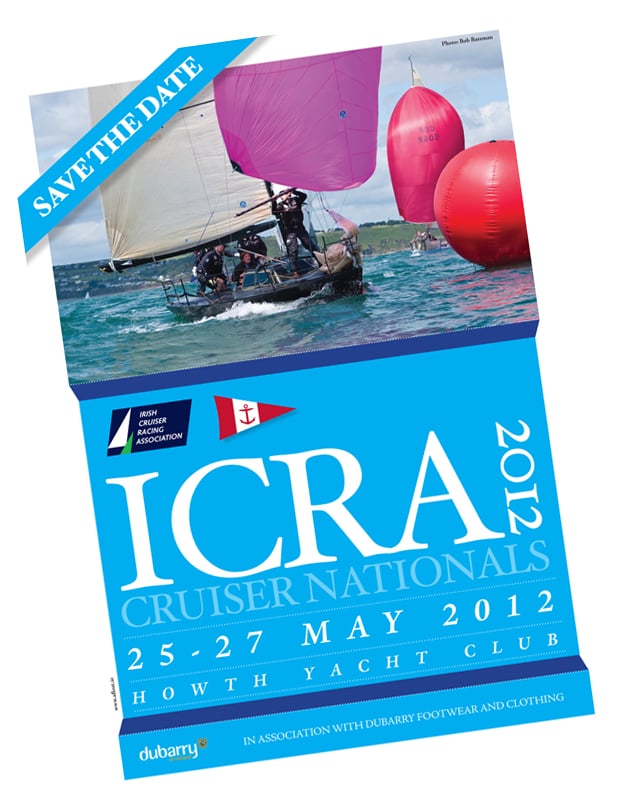
In spite of a dip in the size of the Cruiser fleet in Howth in recent years local boats are still taking some of the big prizes nationally with Reilly's Crazy Horse the 2011 Volvo Dun Laoghaire and DBSC Cruiser Challenge winner and Pat Kelly's J109 Storm picking up the weekend conference's top 'Boat of the Year' prize.
Ashore there are plans to make the event family oriented and a 'ladies lunch' is also planned.
The weekend's ICRA conference decided to do away with the crew limit rule for the seven race series in Howth as the association focuses on getting more crews out on the water to enjoy cruiser racing.
The ICRA Nationals goes West for a return visit to Tralee Bay Sailing Club in June 2013 and in 2014 the National Championships will be staged by the Royal Irish Yacht Club in Dun Laoghaire.
In the normal cycle of things 'the ICRAs' should be heading to the south coast again in 2015 but so far, the conference heard, the association is open to offers.
The 2012 ICRA Notice of Race for the Howth Championships will be available on Afloat.ie shortly
2011 Port of Cork Cruise Season Draws to a Close
With these high numbers of calls and increasing passenger numbers, the overall economic contribution of the cruise business in Ireland is estimated to be worth €60 million to the island of Ireland. Cork alone contributes an estimated €20m to the local economy both directly and indirectly. In a recent survey carried out by Red C Research on behalf of Cruise Ireland, the look of a port is seen to be a key feature, with those arriving into Cork port citing this as very important in encouraging passengers to disembark and take an excursion. Over 90% of passengers visiting Cork were satisfied with their experience which exceeded their expectations.
Captain Michael McCarthy, Commercial Manager Port of Cork commented on the cruise business saying: 'with so many passengers arriving into Cobh and Cork, the impact this has on the local economy is very positive with the average spend per in-transit passenger approximately €73 per day.'
Continuing Captain McCarthy talked about Cork's potential saying that: 'In 2012 the numbers of calls are already looking very positive with 58 liners expected. As it is the 100th anniversary of the Titanic, Cobh will play an important part in commemorations and already there are three liners booked to call, which are basing their cruise theme around the Titanic.'
Feedback from cruise companies visiting Cork is very positive. Direct access to the quayside for passengers coupled with the accessibility of trains to Cork and the historic town of Cobh and its attractions on their doorstep, makes Cobh an attractive port of call. In 2010 the Port of Cork were awarded 1st place for 'Best Destination Experience (Organised)' in the world and 2nd place for 'Best Port Welcome' at the Dream World Cruise awards. These awards along with Cork being voted within the Lonely Planet's top ten cities to visit must be capitalised.
The Port of Cork has ambitious plans to grow the business to 75 calls over the next five years and already 2012 are experiencing that growth, with 58 liners expected to call. Some of these calls will stay overnight and atleast six liners will make their maiden call to Cork in 2012. This growth is attributed to the Port of Cork's investment of over €8 million to date on berthing facilities, which are the only facilities in Ireland capable of handling the largest liners afloat today.
Cruise Liner Traffic to Remain Buoyant in 2012
The Truth About Low Fares
The 2012 Guide explains that bargains do exist, but advises that it's important to read the small print before booking. To reduce prices, cruise lines have to cut costs if they are to stay afloat, and they do so by reducing anything from food portions, training, the strength of coffee, service levels to the variety of green vegetables. When budgeting, cruise-goers should be wary of the following:
add–ons such as government taxes and a processing fee can take the glow off an apparent give-away price
a highly discounted fare may apply only to certain dates and itineraries and it may be subject to a booking deadline
a limited cabin choice, grade and location may be available
being restricted to first seating at dinner
the low fare may not apply to children, and
port charges, handling fees, fuel surcharges or other taxes may cost extra
The 2012 Winners .... and Losers
The hard hitting reviews in this eagerly awaited Guide expose the best and worst scoring cruise ships using an internationally accepted rating system devised by the author, the most feared critic in the business. The only source of independent star-rating of virtually all ocean-going cruise ships worldwide, the Guide takes into account a remarkable 400 separate items based on personal cruises, visits and revisits to ships, as well as observations and comments from Ward's team. Having reviewed 285 cruise ships, the new Berlitz Guide names the top-rating ships for 2012, with the 10 most highly rated being officially 'small' or 'boutique', and explains why they scored as highly as they did. Europa, a 'Small Ship' of Hapag Lloyd Cruises, comes out on top for the 12th year and is once again the only vessel to be placed in the exclusive 5-star Plus 'club'. Seabourn's ships scoop a remarkable 6 of the 10 Top places, while SeaDream gets the top two slots in the Boutique Ships category.
Commenting on Europa's consistency, Douglas Ward, said, "Although Europa is now 12 years old, it continues to score the most points with 1,852 out of a possible 2,000 points. The only ship to have a 3-star Michelin chef on board for most of the year, Europa is a classic that has stood the test of time, and looks almost new, thanks to the dedication of its crew and owners. However, there are movers in the ranks too, with ships going both up and down in star rating, to reflect the changes in service or staff training." Bumping along on the bottom are two National Geographic ships, Sea Bird and Sea Lion, both being small, basic, old ships for wildlife or nature watching. (See Note to Editors for Top 3 Ships in each of the 4 categories.)
The 2012 edition of the Berlitz Cruise Ships App for the iPhone, iPad and iPod Touch allows would-be cruise-goers to quickly search through all 285 ships according to their needs, whether for family travel, cuisine, accommodation, size of ship and many other criteria.
The World's Top Authority on Cruising and Cruise Ships
When it comes to life on the ocean waves, Ward is the world's top authority on cruising and cruise ships, with more than 45 years of experience. He continues to spend up to 200 days a year aboard cruise ships, inspecting and evaluating their facilities. The cruise industry consists of more than 70 ocean going cruise ship operators carrying over 21 million passengers a year. Although the choice can be almost over-whelming, this new Guide will help readers identify the X-factor - that special quality that makes a ship stand out for them.
Fully updated and revised and now in its 27th year, the Berlitz 2012 Complete Guide to Cruising & Cruise Ships, will be available from October 1, 2011 (688 pages, £17.99) from all good bookstores. The Berlitz Cruise Ships 2012 App will also be available during October. For further information visit www.berlitzpublishing.com
Queen Elizabeth Arrives Exactly on Schedule
Despite the squally and blustery conditions, the 294m Cunard Line cruiseship was assisted by the tug Gerry O'Sullivan, was swung swing around in the turning basin off Cobh with the consumate skill of her master Captain Christopher Wells. She eased alongside the deepwater cruise berth fifty minutes later with the first mooring line cast off from the bow to an awaiting lines-boat at 09.00hrs, as exactly scheduled.
MV Queen Elizabeth Makes Maiden Call to the Port of Cork
The luxurious ocean liner, MV Queen Elizabeth will make her maiden call to Cobh tomorrow morning arriving at 9am and bringing with her over 3,000 passengers and crew. With a gross tonnage of 90,900 GRT and a guest capacity of 2,068 and 996 crew, MV Queen Elizabeth is the newest Cunarder to join the fleet.
To coincide with her maiden call, the Port of Cork together with Cunard will hold a Lusitania Memorial Service in the centre of Cobh town. Led by Captain Christopher Wells, this service will be attended by the Chairman of the Port of Cork, Port of Cork Directors, Mayor of the Town of Cobh, the County Mayor and the Lord Mayor. A number of other key figures have also been invited.
Cunard have a great history of calling to the Port of Cork and over the years all of Cunard’s liners have made a visit to Cobh. This year is the first year to welcome all three queens; Queen Mary II, Queen Victoria and Queen Elizabeth to Cobh. In 2009, MV Queen Elizabeth II made her final call to Cobh before departing for Dubai where she was to become a floating hotel.
The following will be read at the Lusitania Memorial Service, by Captain Michael McCarthy Port of Cork;
The sinking of the Lusitania on 7th May 1915 was a human catastrophe on a scale that this small town had not experienced before or since.
When the Lusitania left New York there were 1,962 people on board, 694 crew,1,265 passengers and 3 stowaways. Only 764 people survived – 474 passengers and 290 crew. Over 800 of the victim’s bodies were never found. The bodies landed in Cobh were buried in 3 mass graves in the “Old Church Cemetary”.
The People in Queenstown, Cobh, witnessed the trauma, tragedy and heartbreak that ensued. The dead, the injured and the bereaved were brought among a community here that mobilised itself and responded with courage and compassion to their needs. One of the survivors, Charles Lauriat, later referred in his book “The Lusitania’s Last Voyage” to the streets filled with people ready to do anything in their power to relieve our sufferings. He said he had never seen anything more spontaneous or genuine or more freely given than the Irish hospitality of Queenstown.
This memorial reflects the eternal connection between Cobh, the” Lusitania” and Cunard, and is a stark reminder of the tragedy of war.
It is fitting that today Captain Christopher Wells of Cunard’s vessel “Queen Elizabeth” should be here together with the Mayor and people of Cobh to reflect on the great loss and the human tragedy of the “Lusitania”.
Queen Elizabeth: 73 years ago, Cunard’s first “Queen Elizabeth” entered service. The launching of that ship was described as “the inception of a great human enterprise, an act of faith”. Could they have imagined the design and capability of the current vessel berthed at the Cobh Cruise Berth?
In October 2008, Cunard announced the building of this magnificent vessel at an estimated cost of €500 million euros, and within 2 years the naming ceremony was carried out in Southampton by Her Majesty Queen Elizabeth 11,. The vessel departed on her Maiden voyage under the command of Captain Chris Wells on the 12th October 2010 .She has already completed a World voyage, transited the Suez and Panama Canals and crossed the World’s Oceans.
Captain Wells has already served a long and distinguished career in the Merchant Navy and following many years in command, was in 2008 appointed Master of the Queen Mary 2, the same year the QE2 was retired from the Cunard Fleet. He was subsequently appointed the first Master of the Queen Elizabeth in 2009






























